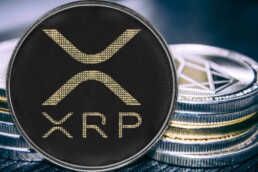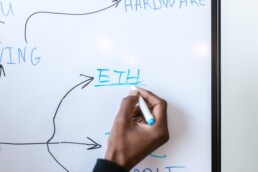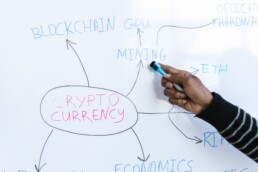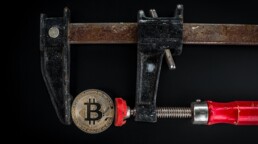XRP and Ripple
There is a coin in the cryptocurrency world that is considered a cryptocurrency when in fact it is not.
We are talking about XRP, created by the company Ripple. In common parlance XRP and Ripple have become synonymous, but the token's only name is XRP. This coin was not created with the idea of being a more functional alternative to Bitcoin, but to be a tool in the hands of the banking world by creating an alternative system to Swift.
XRP is not a real cryptocurrency because it is not totally decentralized.
In fact, Ripple began in 2012 as a system for transferring funds through a network for currency exchanges. In September 2018, Ripple was the second largest coin in the cryptocurrency market by market capitalization.
Ripple controls and manages XRP and has agreements with banks around the world. its code is open source and the value of the coin is affected by the value that is also assigned to the company.
Ripple was created solely to replace old systems such as swift, western union and moneygram with a cheaper system. Not all banks are connected to each other in the world with a single system. This forces banks to switch between different intermediaries in different countries, with long time and big cost for every transactions.
XRP is not created to be a store of value or to make transactions between economic actors in the real market but as a technical tool for specific banking actors or Payment Systems, companies, corporations, currency exchanges.
Because of its characteristics, Xrp cannot be mined but is a pre-mined currency. XRP is fast and scalable, in fact transactions in XRP take about 4 seconds versus 5-10 minutes for btc
XRP's wallet works with a minimum deposit of 20 XRP, an sistem created to avoid inordinate growth of accounts on its network for the sole purpose of clogging up the network and slowing it down.
The token is divisible up to 6 digits after zeros and some XRPs are destroyed after each operation, another system to protect the network. In the event of an attack, with thousands of useless transactions for the sole purpose of slowing down network, this system drains the accounts of the addresses that create the transactions.
Ripple's protocol is called rtxp Ripple Transaction Protocol and consists of pcs called validators that manage the network with their shared ledgers. Companies wishing to use Ripple's network must use gateways, which are points managed by banks and useful to those outside the network.
Ripple Labs was created only to offer banks various types of products, in fact RXTP is open source but the ripple products offered to banks are not and are created and developed only by ripple labs.
Ethereum
Vitalik Buterin has given to the world one of the platforms with one of the biggest potentials on the planet. Ethereum has a very interesting future ahead of it.
Ethereum, whose currency is called Eth, is not only on par with btc a currency for exchanging value, but it is a decentralized platform for creating complex applications. In fact, the goal of ethereum is to decentralize the Internet from the network giants of today.
Ethereum is a decentralized platform for the creation and peer-to-peer publication of smart contracts, or in short, contracts that are self-executing and self-fulfilling. The applications of these contracts are and will be of an enormous number and will cover Gaming and gambling, various contracts, certifications, voting, real estate records and much more.
Even the famous ICOs are actually very simple smart contracts tied to the written code base. This code makes the contract immutable once deployed on the network and after blockchain approval.
Complicated smart contracts have a very high inherent level of difficulty and a huge need for security. You have to create perfect programming and be sure that the contract does only what the programmer has decided. Always remember that Code is Law.
The principle behind Ethereum is that since it is a decentralized platform for program development, anyone can create a program that cannot be controlled by any person or group and that program will run on Eth's network. With a little study of Solidity, all intermediaries can be eliminated and developers can work directly on the Blockchain.
Ethereum was launched in July 2015 and has since become the second largest cryptocurrency by capitalization. Its potential is extremely interesting and deserves to be followed .
A lot of applications are being developed on the ethereum network, from DEFI to NFT tokens to decentralized exchanges that are used to exchange tokens of different types, on the same network, eliminating the trust problem of a centralized exchange.
Ethereum's ease of programming has meant that thousands of other coins, which we can call tokens or altcoins depending on the situation, have sprung up on its network.
Tokens can be defined as the tokens for slot machine, and there are different types of crypto tokens. If we take our cue from Finma, the Swiss regulator, we can define them into 3 categories.
- payment tokens not linked to other functions i.e. Bitcoin, Ethereum, Litecoin. These are real coins, born for value exchange.
- utility tokens that serve a single platform or digital service such as Ripple's XRP, or Binance's BNB, and can be exchanged outside their native platform.
- Investment tokens, which, on the other hand, represent asset values, such as shares in real assets, companies, revenues, or the right to dividends or interest payments. These tokens should be considered in relation to their economic function, in a similar way to shares or corporate bonds, or a derivative financial instrument.
How Cryptocurrencies Work
Few people know or remember, that cryptocurrencies originated as a derivative product of another invention. In fact, Satoshi Nakamoto had no intention of inventing another currency.
The most important part of his invention, when he gave the world the whitepaper of bitcoin or” A Peer-to-Peer Electronic Cash System" was that he managed to create a way to create a decentralized payment system. Throughout the 90s of the 20th century, attempts were made to create a digital system, but all these attempts failed miserably. But developing a system as if it were a peer-to-peer file exchange was the right choice
To set up a payment network you need accounts, user profiles and transactions. Easy to understand but then the biggest issue is to prevent users from spending the same money twice with different entities. To solve this, we use a central server that keeps track of all user balances. But if we do not have this authority or do not want a central entity to certify and monitor users, how do we solve the problem?
In a peer-to-peer network, every single node must have a list of transactions and check that they are valid. Most importantly, all nodes must agree with the approved transactions, because otherwise the network immediately collapses.
No one knew how to solve this network consensus problem until 'Satoshi's invention.
If we take away all the marketing and halo of mystery around cryptocurrencies, and go to the 'bones of their definition , we could define them as "a database with limited writeability within it that no one can change unless it meets specific conditions." This sounds like the definition of a bank account in any bank.
To give a correct definition, cryptocurrencies are a method of exchanging value based on internet technology, which use cryptography to carry out financial transactions that are decentralized, transparent and immutable thanks to blockchain technology.
In currencies such as Bitcoin, the database is managed by the various nodes in the network. Each node has a shared ledger inside which the values of each account and the transactions made are put. Transactions are files that say Gigi gave Y btc to Pancrazio and this transaction was signed by Gigi's private key and then sent to the network.
The transaction is known immediately by the network but it takes some time to get it approved. Approval or rather confirmation of the transaction is one of the key parts of the technology. A confirmed transaction is immutable.
Only miners can confirm transactions, through the process called Mining. Mining involves closing blocks of transactions in the blockchain. Before doing this, however, miners must check the transactions, approve them and enter them into the network. When they are confirmed they become part of the blockchain. And to do this they receive other cryptocurrencies as payment.
Technically anyone can become a miner, since there is no central authority that can approve us or not. Of course it takes security rules to make sure that the network is not destroyed by those who have an interest in its demise. In the case of Bitcoin, the system is called proof of work, which is based on the SHA 256 Hash Algorithm and involves the miner finding a hash, to connect the closing block with the previous block. We can define it, to keep it simple, as a cryptographic puzzle to be solved. Solving it, the reward will be some bitcoins. And this is the only way to create new bitcoins.
Cryptography, therefore mathematics, makes the system secure.
So we are not talking about trust between humans, which can be bought or blackmailed. You cannot blackmail or kidnap the child of a mathematical operation.
Some of the most interesting properties of cryptocurrencies are:
Irreversibility: no one after confirmation can cancel a transaction. Wrong address? Nothing can be done about it. Your pc was stolen with the private key? Nothing can be done. The safety net is not there.
Pseudonymity: no account or transaction is connected to real life. However, if you have done a KYC somewhere, your identity is traceable.
Fast and global: transactions are virtually instantaneous, the speed of confirmation depends on the coin, but of ranges from second to 10 min in Bitcoin. They have no borders though since the network is global.
Secure: As long as you own the private key you are safe. Big coins are unlikely to be hacked unless there are deliberate bugs.
Permissionless: you don't have to ask anyone for permission to use your coins. No one can stop you from using them.
Limited Number of Coins: A good portion of cryptocurrencies have a limited supply, such as Bitcoin with its 21 million. In contrast, DOGE has an unlimited supply with a huge daily production. The limited supply is obviously an advantage in terms of maintaining value.
Think about how useful these properties can be to citizen freedom.
The downside of blockchain
By now we understand, the blockchain is a public ledger. So it's a ledger that everybody can look at, if they know how.
So it's a list of who owns what. Even if pseudonymous as Bitcoin, with a KYC within the network, I can know that my neighbor has a significant amount of money or not.
With normal bank accounts this does not happen, we do not know how much our precendent neighbor owns unless he tells us himself or someone lets us know. Not to mention possible hacks of the bank's databases, which should not happen.
Let us start with a basic principle, it is not smart to tell to everybody about our possessions. Whether you are talking about cryptocurrencies or fiat currency accounts. My preference is to always be on a low profile, without flaunting one's possibilities even if they are limited. The personal safety factor should always be understood and considered. There are times and places to flaunt one's favorite Rolex.
The blockchain, unfortunately, as it was conceived and created, has a big privacy problem, which in the coming years will absolutely have to be addressed and solved.
What is a blockchain? Learn more here.
Double Spending
Today we are going to learn what double spending is.
Double spending is the manipulation of the blockchain of any cryptocurrency in order to spend the same amount of coin several times, sending this coins to different addresses.
Let's take an example on the bitcoin blockchain.
If we have only one bitcoin on our wallet, and we send it to Marco, this will be awaiting confirmation in the network mempool.
Immediately after closing the transaction to Marco and before waiting for the confirmations, we will send the same amount to Giorgio, and this transaction will also end up in the unconfirmed transaction pool.
When these transactions are checked by the miners, the second transaction will be rejected as invalid and impossible to carry out.
In case of simultaneous sending of several transactions, we will have to wait for the 6 confirmations to understand which of the two transactions will be rejected and which will not
From one wallet to another - The transaction of a Bitcoin
In this article we will see what happens from when we send a bitcoin to when it is received from another address.
There are 3 main parts within a transaction, and these are:
Signing
Broadcasting
Confirming
Let's start from the first one, the signing.
Now, by pressing the send button we are telling the wallet to send the selected bitcoin sum to the address indicated in the space provided.
The wallet then creates a transaction, which is actually a message containing the data of who sends, who receives and how much is sent.
Once this is done, a unique digital signatures is created by mathematically mixing my private key, that is the private key of the sender.
The private key as we know, is a long series of letters and numbers that acts as a password for your bitcoins.
Whoever knows the private key has control of these bitcoins, so you must protect it in every way.
The digital signatures is proof that I have this private key along with my public key.
Remember that each transaction creates a different digital signatures.
After signing the transaction, the system creates a file containing the digital signatures and the transaction message.
This concludes the first step on signing.
In the second step, the broadcasting, the wallet sends the file to the computers that mine the blockchain or have a copy of it.
These computers are known as NODES and each node that receives the file checks it to understand that it is legitimate and correct.
In particular, check that who is sending some coin needs have the funds in his wallet and then confirm the validity of the digital signatures.
Once confirmed as valid, this file is sent to other nodes which repeat the verification process.
When a node receives the file, it keeps it in an area called Mempool or memory pool.
This is a space dedicated to valid but not yet confirmed transactions.
Now let's move on to the status of our transaction, Block explorer is software or a tool on a website to check the status of transactions and navigate the blockchain.
We can check the holdings of all bitcoin addresses, check all transactions and have statistics and information on the network in real time.
If we check our transaction right now, we will see it marked as unconfirmed. this means that our transaction is not yet part of the blockchain.
It is defined as zero confirmation transaction.
In this state the transaction could still be canceled or postponed and we have no guarantees that it will be included in the blockchain.
If you sell products and services, never accept an unconfirmed transaction as proof of payment.
If you remember, when we talked about mining, we said that miners group transactions to create a block of the blockchain and of course miners will take the transactions that will be more profitable, there is a limit to the number of transactions.
So the miners compete with each other to create the blockchain block and this competition is based on mathematical calculations.
The greater the computational power the greater the chances of victory.
When a miner wins the competition, all transactions that are in that block are considered confirmed.
Miners write the history of bitcoin transactions and a block is created every 10 minutes.
When we go back to check our transaction, if it is written inside a block, it will be marked as with 1 confirmation.
Confirmations will grow as block creation increases.
The transaction will be fully confirmed with 6 confirmations and without any possibility of cancellation.
The transaction will now be received and it will unmodifiable.
51% Attack !
Today we understand the meaning of the term 51% attack.
Bitcoin miners in fact use their powerful computers to keep the bitcoin network alive by managing and processing all transactionslike checking that the users dont create any double spending trouble on the network.
This very important work, which guarantees the functioning and trust in bitcoin, is done by controlling the blockchain in its entirety.
To give an example, in the case of a transaction on the bitcoin blockchain from user A to B, the miners will check that the transaction is valid, that there are on the address of user A those bitcoins that he wants to move towards the address of user B.
If most miners certify the transaction as correct, then it will be confirmed and entered on the blockchain.
Now, if you had more than 50% of the computing power of the blockchain, it could theoretically be manipulated, carrying out double spending and other types of fraud such as preventing any transactions from specific addresses or eliminating other miners from the network.
The problem is real especially if the computational power of the blockchain is concentrated in the hands of a few connected and colluding hands. In this, the decentralization of mining should avoid this problem. If we think in the event that most of the computational power is in the hands of two or three large companies, the problem of dealing with a cartel is real.
Learn more about safety here.
Various types of Bitcoin wallets
Today we are going into details about the different types of wallets for Bitcoin.
As I have already told you, having a wallet where you can put your bitcoins is essential, it is one of the absolutely necessary steps to invest.
However, there are different types of wallets, all created accordingly to the needs of the owners.
The first diversification is between custodial and non-custodial wallet.
A custodial wallet is for example a wallet on an exchange, where you can use the wallet but you don't have control over it since you don't have the private keys.
Non-custodial wallets, on the other hand, are wallets that you can access via private keys and are in your full control.
This category is divided into hardware wallets and software wallets.
Let's start with the first type, namely the hardware wallets.
A hardware wallet is a physical wallet, practically a USB key that we can hold in our hands.
The most famous models are the Nano S or X and the Trezor.
These wallets are perfect for securing large amounts of coins and are fairly easy to use.
Another point in their favor is the vast support, in fact they allow you to have different types of coins saved inside them.
The safety of use is one of the fundamental points of this type of wallet, safety that you pay dearly given the purchase cost, based on the wallet model chosen, which is particularly high.
These wallets then need to use special software to work, such as Ledger Live for the Nano.
Let's move on to software wallets, which are a type of wallet that we can have on a device such as a phone or laptop.
One of the most popular wallets is electrum wallet, which is free and open source. It is a wallet dedicated only to bitcoins and we must say that it does not have a really nice user interface. But it works, is appreciated by users and is safe thanks to the fact that it is open source.
It also works with some hardware wallets.
Now let's talk about the wallet of hardcore Bitcoin professionist, let's talk about bitcoin core wallet.
Now let's understand, this wallet is specific only for people who know what they are doing since it downloads the entire bitcoin blockchain on their pc, and we are talking about gigabytes of memory.
This wallet is the ultimate in privacy and is obviously only for bitcoin and only for pc.
You will have complete autonomy and full possession of the tools of the bitcoin blockchain, so it is not for those who are just starting out. Even the interface doesn't help.
Now that you know what the various types of wallets for your bitcoins are, you just have to decide what to use in complete safety.
Learn more about safety here.
How to choose an Exchange - Rookies
Today we see how to choose an exchange for buying and selling our cryptocurrencies.
First of all we must understand at what point of our path we are, this guide wants to be a sort of how to for complete newbies.
There are some basic things to know and consider before choosing your trusted exchange.
Let's start with the idea that all large exchanges tend to be more or less equivalent in the service you will use at the beginning, but moving forward you will obviously also notice substantial differences.
One of the first differences that we can check is the trading location of the exchange and consequently which customers the exchange accepts, based on their country of origin or residence.
For example, US clients are not always accepted on some Asian exchanges.
Another difference lies in the methods of payment of crypto or, to better define it, in the method of entry into this world.
In fact, not all exchanges accept fiat money deposits.
Many exchanges only accept stable coins and not all of them. In this case you would find yourself with some euros on your hands without knowing how to get them to your exchange and you would have to find an alternative method, such as switching from another exchange that accepts fiat money.
Then the usage fees must be considered.
We've already talked about what fees are, and how they can destroy your profitability.
The more expensive an exchange is, the harder it will be to make sure your trading is positive.
The KYC or customer verification system is another thing to consider.
There are exchanges that do not allow you to operate without your documents while others give you an operating or withdrawal limit.
And then lastly, the number and which coins are listed on the exchange.
Choosing an exchange with a limited number of coin is not a long-term choice, unless you are a specialist of those specific coins.
Instead, an exchange with a good number of coins, to which more are added, will allow you to increase your future earnings.
Learn more about safety here.
Step 2 - What is a Blockchain?
Blockchain, a term now abused and inserted inappropriately in many contexts because it is cool and makes us feel important.
Sounds like in the early 2000s we heard from our shoemaker who had opened his website and he has no idea about what doing with a website.
But what is a blockchain ? What is his purpose? And why is it useful in some situations?
The BlockChain is a distributed and decentralized digital database, shared on a series of nodes, verifiable by anyone and immutable over time.
It is a digital register, whose entries are grouped into blocks linked together in chronological and sequential order, whose integrity is guaranteed by the use of cryptography
Decentralization is guaranteed by the network of nodes distributed around the world, and each of these has a copy of the database, which is distributed among all nodes in the network. To put it simply, nodes are computers around the world owned by individual enthusiasts or large mining companies.
Each new block addition to the distributed blockchain is globally governed by a shared protocol.
Once the addition of the new block has been authorized, each node updates its private copy with the guarantee of automatically discarding fraudulent or incorrect blocks.
Therefore the information written inside the distributed blockchain, owned by each node will always be visible to everyone and this information will never be changed in the future.
It is practically impossible to change information within a block, the computing power required would be enormous.
Thanks to these characteristics, the blockchain is intrinsically superior to normal databases and central controlled registers, managed even by recognized and regulated authorities.
As with every product, variants are developed and various types have also been developed for the Blockchain, created to meet the various needs of every actor operating in the world.
in detail:
- Public blockchains: Blockchains are open to everyone and accessible to anyone. Each node holds a copy of the database and can participate in the decision-making process regarding the state of the ledger. They are defined as "permissionless". Example: the Bitcoin blockchain
- Private Blockchains: They are closed Blockchains where only one or more pre-selected nodes can perform the function of validating the network. They are defined as "permissioned". Example: the Blockchain of a private foundation or a company
- Mixed Blockchains: They are partly public and partly private Blockchains
- Sidechains: They are blockchains derived from the mother blockchain but connected to it. They are in effect autonomous blockchains on which it is expected that there are coins / tokens different from those circulating on the parent chain but which, if necessary, can "move" from the sidechain to the parent chain and vice versa.
To recognize a blockchain we need to find these elements:
- Transaction (transfer of value from one address to another)
- Block (element that contains transactions)
- Node (element of the network that performs for example mining or validating transactions)
- Peer to peer network (network in which all nodes can communicate with each other)
- Smart contracts that deal with the management, fulfillment, execution and payment of the agreements between the parties
In these days, the blockchain is used practically only for payments and exchange of goods and services.
But we can already speculate that in the future, its usefulness may be much wider.
To date, it is assumed that the blockchain can be used for situations where traceability and information security are required, such as:
- Sharing of health information between different platforms and institutions;
- Schools, academia, training areas, issuing of certificates
- Management of sporting events, demonstrations, Olympics
- Management of betting in general and casinos
- Real estate sales and land registers
- Traceability of non-profit and charitable donations
- Monitoring of guns, ammunition and explosives trade
- Law enforcement and public safety management
- Cybersecurity
- Systems for digital and biometric identification
- Production and sale of diamonds or raw materials
- Insurance and leasing sector
- Wills and inheritance
- Tourism
- Traceability of supply chains
- Certification of works of art
- Transparent online voting, safe from manipulation and fraud
- Banking, finance and investment platforms
- Payment and money transfer systems
- Loyalty cards and gift cards
- Telephony
- Trade and industry
- Automotive sector
Summarizing the Blockchain:
- It is decentralized (it does not have central authorities, everyone can see, use and consult it but no one owns it)
- The protocol is open (in public blockchains)
- Certifies that "something" (a transaction of value, a change of ownership) has taken place. The transaction cannot be censored by a central authority
- A transaction cannot be prohibited, censored or regulated by a sovereign entity (e.g. credit or debit card blocking)
- It is verifiable by anyone (in the traditional financial system, the system controls everyone while in the blockchain ecosystem, everyone controls the system)
- Cannot be tampered or falsifiable (intrinsically safe consensus protocol)
- Solves the problem of double spending
- It is immutable over time. Once a transaction has been validated, it is fixed for "life"
- It is dynamic in the sense that blocks are always added












